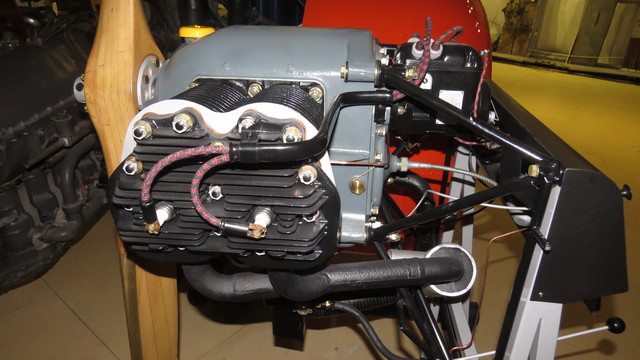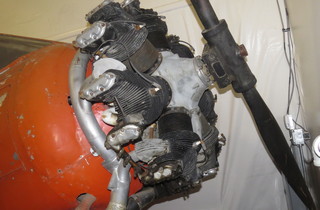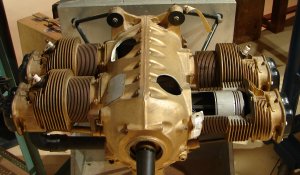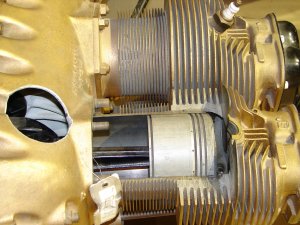From Continental A-40 Brochure
- Protection All materials used in the A40 engine are carefully inspected and tested in a completely equipped metallurgical laboratory. Perfection is thus attained from the very beginning.
- Visibility The horizontally opposed arrangement of cylinders affords unobstructed visibility for the pilot.
- Smoothness Four cylinder design with good distribution and carburetion is responsible for the exceedingly smooth and vibrationless operation of the engine throughout its power range.
- Flexibility The A40 is a four cycle engine and is flexible and responsive to the throttle from low idling to maximum speed.
- Low Resistance Compact, smooth crankcase, and short L-head cylinders offer little resistance to the air stream.
- Simplicity Elimination of superfluous accessories, simple construction and ready accessibility of parts, make the A40 an ideal engine for the individual owner. This is shown in the following description of the engine's fundamental parts:
Crankcase
The crankcase is a one-piece, heat-treated, aluminum alloy casting, with smooth exterior and well ribbed internally for strength. Front crankshaft bearing and both camshaft bearings of special bearing bronze are pressed into the case, and valve tappets are carried in long bosses. Oil reservoir is provided in base, and engine support lugs are cast on the rear end of case. An aluminum rear cover carries a bearing support into which is pressed the rear crankshaft bearing. All bearings are align-reamed in place. The magneto, driven directly from the crankshaft, bolts to a flanged mounting on the rear cover, and a tachometer connection operated from the camshaft is provided.
Cylinders
Cylinders are made of nickel iron and cast in pairs with provision for air circulation around each barrel. Ample cooling area is provided by fins cast on barrels and heads. Cylinder bores are ground to a mirror finish within very close limits. Each cylinder block is attached to crankcase by six studs and nuts. Cylinder heads are removable and cast in pairs of heat-treated aluminum alloy. Bronze spark plug inserts are cast in place and the head casting is secured to cylinder block with fifteen studs and nuts. Between cylinder block and head is inserted a copper aluminum gasket.
Pistons
Trunk type pistons are made from heat-treated, permanent mold, aluminum alloy castings. The heads are thick to dissipate heat, and long skirts minimize scuffing. Three compression and one oil control rings are above the piston pin which is secured by snap rings.
Connecting Rods
Connecting rods are made from heat-treated carbon steel forgings. Separable caps bolted to the rods and are fitted with permanently spun-in babbitt bearings. Bronze piston pin bushings are pressed into coined bosses and reamed in place.
Crankshaft
The crankshaft is a one-piece, four throw, high carbon steel forging which is heat-treated and completely machined. Counter-weights are forged integral with the crankshaft. The shaft is drilled throughout for lightness and plugged to provide an oil passage. It is supported by two bearings of special bearing bronze, with provision for thrust in either direction to accommodate tractor or pusher installations. SAE No. 0 taper shaft is furnished with a propeller hub.
Camshaft and Valve Gear
Individual cams are forged on the camshaft, which is made of heat-treated carbon steel and is drilled for lightness and to provide an oil passage. Cam lobes and bearing journals are case hardened and ground. The forward end of the shaft is slotted to operate the oil pump blade and the rear end drives the tachometer. Chrome nickel, tungsten steel valves are operated by long, round nosed, steel tappets, provided with screw and lock nut adjusting mechanism.
Intake System
Fuel mixture is provided by a single carburetor attached to the bottom of the crankcase. The riser from carburetor passes upward inside the case where it branches right and left and connects with the cylinder ports by means of intake pipes. Oil heats the intake mixture while the cold charge cools the oil./
Lubrication System
An automatically primed, blade type oil pump furnishes pressure lubrication to main, crankpin and camshaft bearings. Oil is forced through drilled passages in crankcase, crankshaft and camshaft to various hearings. Pump intake is through a drilled boss extending to bottom of oil reservoir eliminating the use of oil tubes. Cylinder walls and piston pins are lubricated by spray. Oil reservoir holds three quarts of lubricant which is measured by bayonet oil gauge. Pressure relief valve set to give approximately 35 pounds pressure at 2,500 rpm.
Test
Every engine is subjected to a run-in period and a seven hour test which includes a five hour, -full load, full throttle period, a disassembly and inspection of parts, and a final two hour check run. These carefully supervised tests are the last qualifications for the engine to hear the Continental winged seal of merit.
CONTINENTAL AIRCRAFT ENGINE COMPANY
Detroit, Michigan, U.S.A.



